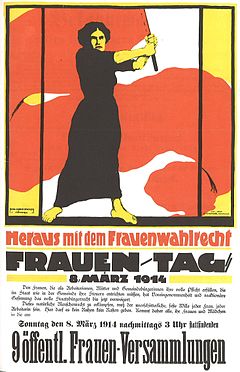International Women's Day (IWD), originally called International Working Women’s Day, is marked on March 8 every year.In different regions the focus of the celebrations ranges from general celebration of respect, appreciation and love towards women to a celebration for women's economic, political and social achievements.
In many regions, the day lost its political flavour, and became simply an occasion for men to express their love for women. However, the original political and human rights theme designated by the UN runs strong, and political and social awareness of the struggles of women worldwide are brought out and examined in a hopeful manner.
The1st National Women's Day was observed on Feb 28, 1909 in the United States following a declaration by the Socialist Party of America.
In August 1910, an International Women's Conference was organized to precede the general meeting of the Socialist Second International in Copenhagen,Denmark.
Inspired in part by the American socialists, German Socialist Luise Zietz proposed the establishment of an annual 'International Woman's Day' (singular) and was seconded by Clara Zetkin, although no date was specified at that conference.Delegates (100 women from 17 countries) agreed with the idea as a strategy to promote equal rights, including Suffrage(Civil Right to Vote), for women.
On
March 18, 1911, International Women's Day was marked for the first
time, by over a million people in Austria,Denmark,Germany and
Switzerland.
On May 8, 1965 by the decree of the USSR Presidium of the Supreme Soviet International Women's Day was declared a non working day in the USSR "in commemoration of the outstanding merits of Soviet women in communistic construction, in the defense of their Fatherland during the Great Patriotic War, in their heroism and selflessness at the front and in the rear, and also marking the great contribution of women to strengthening friendship between peoples, and the struggle for peace.
Official UN Themes
| 1996 | Celebrating the Past, Planning for the Future |
| 1997 | Women and the Peace Table |
| 1998 | Women and Human Rights |
| 1999 | World Free of Violence Against Women |
| 2000 | Women Uniting for Peace |
| 2001 | Women and Peace: Women Managing Conflicts |
| 2002 | Afghan Women Today: Realities and Opportunities |
| 2003 | Gender Equality and the Millennium Development Goals |
| 2004 | Women and HIV/AIDS |
| 2005 | Gender Equality Beyond 2005; Building a More Secure Future |
| 2006 | Women in Decision-making |
| 2007 | Ending Impunity for Violence Against Women and Girls |
| 2008 | Investing in Women and Girls |
| 2009 | Women and Men United to End Violence Against Women and Girls |
| 2010 | Equal Rights, Equal Opportunities: Progress for All |
| 2011 | Equal Access to Education, Training, and Science and Technology: Pathway to Decent Work for Women |
| 2012 | Empower Rural Women, End Poverty and Hunger |
| 2013 | A Promise is a Promise: Time for Action to End Violence Against Women |
| 2014 | Equality for Women is Progress for All |
| 2015 | Empowering Women, Empowering Humanity: Picture it! |
German poster for International Women's Day, March 8th, 1914; English : “Give Us Women’s Suffrage. Women’s Day, March 8, 1914. Until now, prejudice and reactionary attitudes have denied full civic rights to women, who as workers, mothers, and citizens wholly fulfill their duty, who must pay their taxes to the state as well as the municipality. Fighting for this natural human right must be the firm, unwavering intention of every woman, every female worker. In this, no pause for rest, no respite is allowed. Come all, you women and girls, to the 9th public women’s assembly on Sunday, March 8, 1914, at 3pm.”

1975 was designated as International Women’s Year and the UN gave official sanction to, and began sponsoring, International Women's Day.Many Countries issued Stamps commemorating IWD









No comments:
Post a Comment